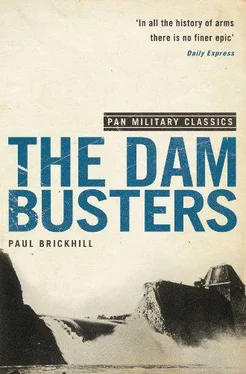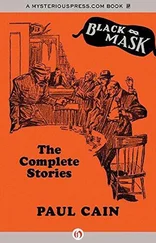Wallis’s was. He started by outlining his theory of crippling an enemy by destroying the sources of energy, and went on to discuss in exhaustive detail the physical qualities of the targets, shock waves, blast, penetration, bomb design, aircraft design, charge/weight ratios, aiming problems, possible effects, repair potentialities, backed up with pages of graphs and formulae and equations. It was a tour de force, explaining step by step so lucidly that a layman could follow it if he took the mathematics for granted.
The “note” took Wallis several months, and then he had it roneoed and bound and posted copies to seventy influential men in science, politics and the services.
Results were not long coming. A secret service man called on him with a copy of the “note” under his arm.
“Did you send this to Mr.—?” he asked.
“Yes,” Wallis said. “Why?”
“I’m afraid you shouldn’t have done so, Mr. Wallis.”
“Why?”
“It’s very secret stuff. This sort of thing must be handled very carefully and only reach authorised persons. Mr.— was very surprised when this arrived in the post. We were concerned too. I quite realise you didn’t mean to be…”
“I sent out seventy of them,” Wallis said calmly, and the Secret Service was appalled.
“Seventy!” he said. “ Seventy! Who? To whom? But you shouldn’t have. This is vital and very secret! “
“Is it? “said Wallis mildly. “When I showed it to the authorised persons they said I was mad. I’m supposed to be a crackpot and this is regarded by authorised persons as fiddle-faddle.”
The secret service man said, “Oh! “He asked for the names of the seventy. Wallis read them out and the secret service man, who seemed a little uncertain of his ground, went back to London to investigate further.
He appeared again a couple of days later.
“Well, it’s all right,” he said, “this time. We’ve decided that as so many were sent out so openly it’s actually rather a good form of security. No one will dream it’s all so secret. But please don’t do it again.”
Wallis bowed gravely. “I hope it will not be necessary again,” he said and the incident was closed.
A few days later there was another result. A copy had reached a Group Captain Winterbotham, who had an office in the City and was used to dealing with unorthodox aspects of the war. He had found it convincing, called on Wallis, and Wallis explained more fully. Winterbotham caught some of his enthusiasm. He knew Sir Henry Tizard, who was scientific adviser to the Ministry of Aircraft Production, and drew his special attention to Wallis’s paper.
Tizard read it carefully; as a scientist he could follow the intricate calculations. He went down to see Wallis at Wey-bridge and was impressed.
“I’d better form a committee to study this more fully,” he said. “It would have to have pretty solid backing from expert opinion. You’ll understand, I know. It would divert effort from other important things if we were to go ahead with it and we’ve got to be reasonably sure it would be worth while.”
“Of course,” Wallis said. He felt like singing.
Not long after, Wallis met the committee. At the head was Dr. Pye, Director of Scientific Research at the Ministry of Supply, and the others were scientists too. Wallis explained his ideas and described the probable effect on Germany’s war industries if the dams were breached. There was only one really worthwhile time of the year to breach them, and that was in May, when the storage lakes were full after the winter thaw and spring rains, and before the sluice gates were opened to water the country and canals for summer. Then you would get the greatest floods, the most serious loss of water and power. Dr. Pye said the committee would be a few days considering.
A week later Wallis faced the committee to hear their findings. His worst fears were soon over; the report was fa vour-able, but, as they read on, a little disappointingly so. They thought that the dams showed possibilities and the upshot was another committee. This one focused the aim more definitely; it was to be called “The Air Attack on Dams Committee.”
The members were again scientists and engineers and in a mood to be interested in something new because even German bombs, though they were more efficient than R.A.F. bombs and killed thousands of civilians, had demonstrated the limitations of small bombs.
“With this big bomb,” Wallis earnestly impressed on them, “you don’t have to get a direct hit. I think a ten-ton bomb dropped fifty feet away stands a good chance of knocking a hole in a dam like the Moehne. A near miss like that ought to be simple enough to organise.”
One of the members, Dr. Glanville, of the Road Research Laboratories at Harmondsworth, suggested building a model dam and testing the theories with scaled-down charges of explosive. Wallis accepted delightedly.
Over the next few months, whenever he could spare time from his arduous work at Vickers, Wallis helped Glanville design and painstakingly build a model dam one-fiftieth the size of the Moehne with tiny cubes of concrete, scale models of the huge masonry blocks in the real dam. The model was about 30 feet long, 33 inches high and up to 2 feet thick, a low wall arched between earthern banks, secluded from prying outside eyes in a walled garden.
They flooded the ground at one side to simulate the lake, and Wallis exploded a few ounces of gelignite under the surface 4 feet from the model to give the effect of a 10-tonner going off 200 feet away. There was a commotion on the water and a couple of patches of concrete flaked and chipped.
“Not so good there,” Wallis said. “Let’s try it closer.”
He exploded more gelignite 3 feet from the dam, and there was a little more damage. He set off another charge 2 feet away and still found only minor chipping.
At a distance of 12 inches (representing a 10-tonner 50 feet from the dam) the gelignite caused a couple of cracks in the outer structure; but they were small cracks, not enough to harm the dam significantly. They tried several more charges but the cumulative effect was not encouraging.
Months had passed since the first hopeful meeting of the committee, and Wallis could see that their early co-operation was freezing. Glanville built another model, and Wallis tried bigger charges to see what would smash the models at a distance. One day a few extra ounces of gelignite a foot away sent a mushroom of water spraying over the wall round the garden and as the spume cleared they saw the water of the little lake gushing through the burst dam. Slabs of concrete had cracked and spilled out and there was the breach that Wallis had been wanting. He calculated the scaled-up charge which, dropped 50 feet away, would smash such a hole in the Moehne. The answer was something like 30,000 Ib. of the new explosive RDX, and the gentle scientist did not need pencil and paper to estimate the significance.
Thirty thousand pounds was nearly 14 tons. That was the explosive alone. Add the weight of the thick case of special steel—another 40,000 odd Ib. It meant a bomb weighing 70,000 Ib.—over 30 tons, and the Victory Bomber, still only on paper and straining the limits of feasible aircraft construction, would carry only a 10-tonner.
The next meeting of the Air Attack on Dams Committee was in a fortnight and it required little thought to foresee it would be the last meeting.
Wallis would not give up.
Supposing, he thought, a bomb could be exploded under water against the dam wall. The shock wave punch would be much greater. So the explosive needed would be smaller. So would the bomb casing.
But how to get a big bomb in the exact spot—deep enough for the shock punch and pressed against the wall to make the most of it? Or, as it might require more than one bomb, how could you get them all in the exact spot? A torpedo? But the dams had heavy torpedo netting in front of them, and so torpedoes were out. You could drop a bomb from very low level for accuracy, but bombs don’t simply “drop “. Just after release they carry a lot of forward speed, giving them almost a horizontal trajectory for a while. If you dropped a bomb— even a whopper—from very low to get the accuracy it would simply skid off the water; so that was no good. If you dropped it high enough to enter the water cleanly, you only had about one chance in a thousand of putting it right in the exact spot.
Читать дальше












